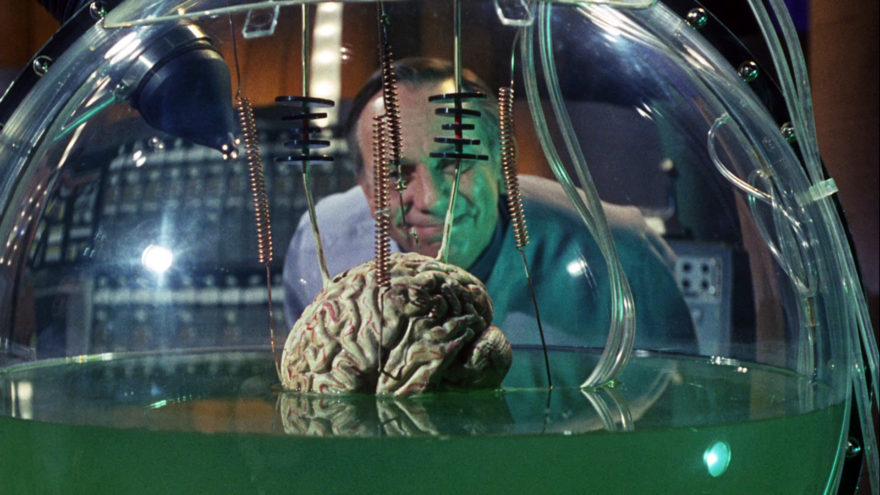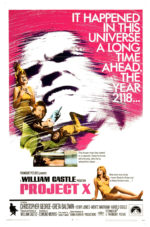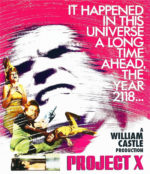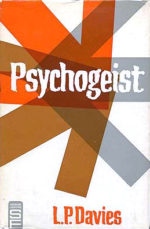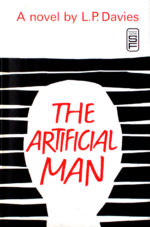Project X is the most amazing blend of lofty science fiction ideas and B-movie cheesiness you will likely ever see. Directed by William Castle—renowned creator of low-budget horror classics like The Tingler and The House on Haunted Hill—this was his only straight up science fiction feature.
By Jon Stout
The film is set in the distant future where a heroic spy broadcasts a cryptic message—“The West will be destroyed in fourteen days”—just moments before his memory is erased. A team of scientists is tasked with bringing him out of a cryogenic freeze and figuring out how to restore his deleted memories so they can defend against the attack. The film takes every twist and turn imaginable until a disembodied brain floating in a globe filled with green liquid is forced to reveal its darkest secrets. Sounds futuristic, right? But wait, the only way to get our hero’s brain to reboot is to make him think he’s living in the distant past—the 1960s—as a bank robber hiding out in the countryside. And although I may have had to bend myself into a pretzel to explain this premise, the film’s writer actually makes this all make sense—well, as much as you can. And actor Henry Jones (who appeared in everything from The Twilight Zone to Arachnophobia) delivers pages of explanation with such a twinkle in his eye, and such a tinge of sarcasm, that makes it almost a joy to watch.
But don’t forget that behind its flimsy 60’s façade, this film tackles compelling science fiction ideas, exploring the still-relevant issue of how to peer inside the human brain and pluck out individual memories. And it provides a subtle and subversive social commentary, similar to Starship Troopers, about a future society that sees itself as perfect, but is blind to its own suffocating social order: the future is just as petty and messed up as any era of mankind’s history. And yet this truly terrifying world is somehow made a bit ridiculous by setting it in a run-down farmhouse where a future scientist obsesses over what a potato is and how to cook it.
The film itself was shot on a shoestring budget with a crew that worked mostly in the world of television, which explains why it looks like a tv movie. It was a quick shoot with only a few sets and clearly takes place in the 60s to save money. Castle was also saddled with Greta Baldwin as his leading lady. She was a very popular German model and the sweetheart of Paramount Studio owner Charles Bludhorn, who made sure she arrived each day in a black limo. What she lacked in acting ability she made up for in confidence and spunk.
This film never stood a chance when you consider its competition; 2001: A Space Odyssey, Planet of the Apes, Barbarella and even Quatermass and the Pit (aka Five Million Years to Earth) were all fellow 1968 releases. But Project X has a charm and a sense of fun that seems to reflect the personality of its director. Everyone William Castle worked with said he was friendly, kind and upbeat. Monte Markham, the film’s villain, said that everyone on the set looked at each other with a knowing eye: they were on a William Castle film, they were going to be professional, but they were also going to have some fun. Markham recalls that he did all his own stunts in the film and also performed his first-ever onscreen punch in a scene with Marlon Brando’s stunt double—and accidentally gave him a bloody nose.
William Castle had always relied on ‘gimmicks’ to promote his films, and he had intended to use one with Project X as well. He had Paramount’s VP of production, Robert Evans, put out a press release announcing that Project X would feature “a new ‘secret’ filming concept…including actual working of the mind through depictography and holograms.” (In case you were wondering, depictography seems to be a made up word.)
Sadly, this gimmick died on the vine when he teamed up with Hanna-Barbera to create these effects. Beloved animator Alex Toth, known for Space Ghost and Superfriends, was assigned the project and created some very realistic grease pencil illustrations, but his boss said that would be too expensive. He used a different approach, but when he saw the results cut into the film he told the editors it looked terrible—and that was the end of his involvement in the film.
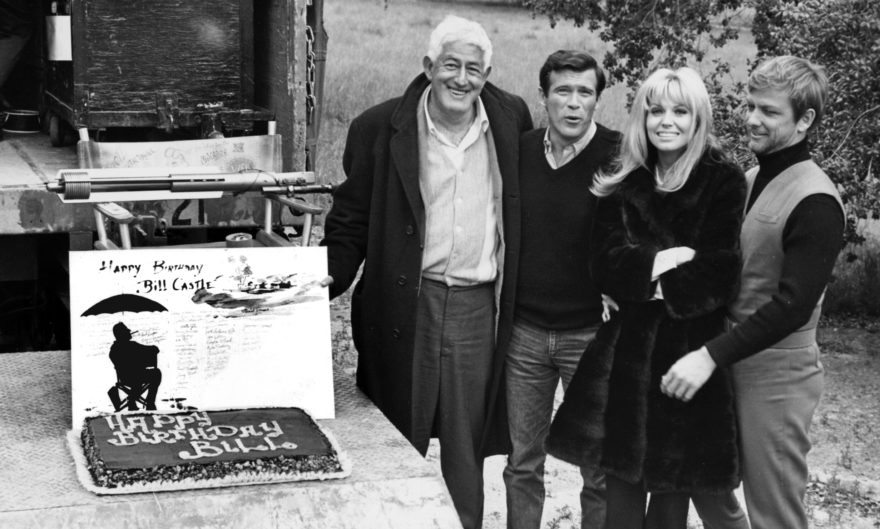
William Castle, Christopher George, Greta Baldwin and Monte Markham celebrate a birthday on the set of Project X
Project X came along near the end of William Castle’s career, and the movies were changing around him. He knew this and was already looking to reinvent himself by purchasing the rights to the terrifying novel Rosemary’s Baby before it was even published. It was the dream project that would finally earn him respect as a director. But Paramount Studios worked a deal with him and brought on Roman Polanski to direct instead. Castle stayed on as the producer of the film and did earn his place in the spotlight—as the film turned out to be one of the best horror films of all time. Ironically, though, Project X didn’t appear broadly in theaters until it played as a double bill with Barbarella, which was months after Rosemary’s Baby had already been released. There was no way a low-budget genre film like Project X could ever look like a great follow-up to a film like Rosemary’s Baby—it did not do well in the box office and this helped tarnish the reputation Castle had earned with Rosemary’s Baby. It’s unfortunate because, in the right context, Project X has a lot to offer.
I can’t help but think of Mr. Castle—in the midst of his negotiations with Paramount Pictures to finance Rosemary’s Baby—on the set of Project X, enjoying his last bittersweet moments as a B-movie director, with the actors standing around a pulsating plastic brain and him thinking of his next project: the horror classic that would finally make him the A-list director he had always dreamed of becoming.
Special Thanks to Monte Markham
Set Photo from the Margaret Herrick Library
Enjoying the site? If so consider supporting it with alien-infused caffeine…


